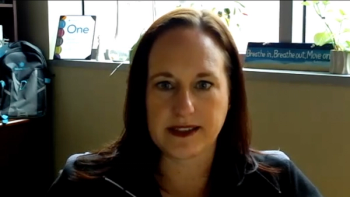
Oncology NEWS International
- Oncology NEWS International Vol 17 No 3
- Volume 17
- Issue 3
Medicare hospice benefit cap creates fiscal crunch for providers, as non-cancer patients live longer
According to recent reports, a growing number of non-cancer patients are outliving the cap on the Medicare hospice benefit, putting some hospice providers on the brink of bankruptcy.
According to recent reports, a growing number of non-cancer patients are outliving the cap on the Medicare hospice benefit, putting some hospice providers on the brink of bankruptcy.
Medicare’s hospice benefit has become one of the fastest growing components of the budget, prompting action from the federal government. Hospices that exceed the per-patient cap reimbursement must repay the difference to Medicare.
The cap is determined by multiplying the number of patients by the per-patient allowance-$21,410 in FY 2007. Repayment demands can run into hundreds of thousands of dollars, an untenable burden for small providers.
Adding to the problem, with the baby boom generation about to flood the Medicare program, the trend will continue to escalate.
Changing demographics
Originally designed in 1982 for terminal cancer patients, the Medicare hospice program has expanded its care for patients with illnesses such as dementia and Alzheimer’s disease, who often outlive the 6-month benefit period. Hospice advocates contend that due to this changing patient demographic of longer end-of-life care, the current system retroactively penalizes hospices for admitting and serving eligible patients and their families.
In an interview with Oncology News International, Jon Keyserling, vice president of the National Hospice and Palliative Care Organization (NHPCO), explained that government policy has not kept pace with the changing demographics of hospice.
“In 1982, when the Medicare benefit was enacted, virtually all hospice enrollees were cancer patients. Today, more than 54% of hospice is composed of non-cancer patients, and we expect that before too long that percentage of non-cancer hospice patients will increase to about 70%,” Mr. Keyserling said. “If anyone did a detailed analysis of the Medicare cap statute, they would see some very obvious deficiencies.”
He mentioned that the Medicare Payment Advisory Commission (MedPAC), the Centers for Medicare & Medicaid Services (CMS), and certain members of Congress who have looked at the cap issue agree that the financial instrument needs to be re-evaluated.
“Short-term, the cap needs to be tweaked, but there also needs to be a substantial review of the program, which has not been done in 25 years. The utility of the cap needs to be questioned,” Mr. Keyserling said.
He acknowledged that the financial issues generated by the hospice cap predominately affect for-profit providers.
“However, we are beginning to see the cap’s effect on a variety of different models with different tax statuses. But the NHPCO, as an organization, does not differentiate between a for-profit and a not-for-profit hospice,” he said.
Mr. Keyserling added that under the Medicare benefit, all hospices have the same mandate for delivering high-quality compassionate care.
It serves no purpose, he said, to highlight the fact that the earliest programs being affected by the cap seem to be for-profit hospices.
“It’s important to note that the number of programs affected by the cap is growing, and in the future, unless fixed, the cap will negatively impact all segments of hospice providers,” he said.
Mr. Keyserling pointed out that the Medicare hospice reimbursement cap, which in effect penalizes hospices for delivering the full spectrum of end-of-life care, is misguided, given the fact that hospice reduces Medicare spending.
He referenced a recent Duke University study that found hospice care saved Medicare an average of $2,309 per person, compared with delivery of “normal” care (Taylor DH et al: Social Science & Medicine 65:1466-1478, 2007).
“Quite frankly, I’m surprised that the administration seems unaware of the Duke study, which demonstrated that hospice is a rare commodity in healthcare-high-quality care that actually saves money,” Mr. Keyserling said.
View from a large provider
According to J. Cameron Muir, MD, vice president of medical services for Capital Hospice, the Medicare hospice cap is actually not one of the main issues in hospice.
Dr. Muir noted that essentially it’s the for-profit hospices that are having cap problems. For-profit providers make up only about 46% of the 4,000 hospices in the United States.
“The for-profit programs are generating significant concerns regarding of the US hospice system,” he said. His organization, Capital Hospice, a not-for-profit program, is the largest hospice in the Washington DC region.
The main concern of most hospice programs is not the Medicare cap but, rather, the need to increase access to end-of-life care, Dr. Muir told ONI. Late entry into the program is a universal problem.
“We’ve seen an increase in the number of cancer patients living less than 7 days after entry,” Dr. Muir said.
There are many patients with terminal illness for whom hospice care would be appropriate, but they either never enroll or enroll very late. He explained that such short stays don’t allow a hospice program time to give a dying patient the full spectrum of care they and their families deserve.
Over-treating dying patients
“We’ve also seen another phenomenon developing, an increase in hospice cancer patients receiving chemotherapy in the last 2 weeks of life,” Dr. Muir said. He suggested that MedPAC conduct a demonstration project to analyze the current payment system, which might be creating incentives for more aggressive curative treatment instead of palliative care.
ONI editorial board member Thomas Smith, MD, Massey Cancer Center, said that a study by Craig Earle and colleagues (J Clin Oncol 22:315-321, 2004) found that 19% of Medicare cancer patients were receiving chemotherapy within 2 weeks of death in 1996, which has certainly increased since then.
Dr. Smith pointed out, however, that end-of-life care has gotten more complex with newer, less toxic drugs available and our realization that the tumor does not have to shrink for symptomatic patients to benefit from therapy.
“So it’s not always, ‘Suffer with your oncologist, relief with your hospice team,’” Dr. Smith said.
Although monitoring excessive healthcare costs is necessary, he said, the judicial use of more aggressive measures in end-of-life care can be beneficial and affordable. With that in mind, he said, one of the biggest challenges for oncology patients and their doctors is the either/or part of cancer care/hospice.
“If you’re in one, you can’t be in the other,” Dr. Smith said. He noted that Medicare pays about $150 per day for hospice. “Not a lot of chemotherapy, transfusions, or radiation therapy fits in that envelope!” he concluded.
Articles in this issue
almost 18 years ago
Recentin headed to phase III in first-line colon caalmost 18 years ago
Topo 2 alpha test FDA approvedalmost 18 years ago
RFA provides sustained pain relief in osteoid osteomaalmost 18 years ago
Renal ca surgery often determined by doctors’ practice stylealmost 18 years ago
Partial nephrectomy underutilized for small renal tumorsalmost 18 years ago
Most older men with early-stage cancer can avoid treatmentalmost 18 years ago
SERM reduces ADT side effectsalmost 18 years ago
New serum biomarker appears to detect colon canceralmost 18 years ago
Hypofractionated IMRT does not increase sexual side effectsalmost 18 years ago
Surface mapping aligns patients for external beam PBINewsletter
Stay up to date on recent advances in the multidisciplinary approach to cancer.































































































